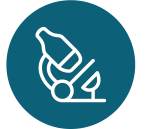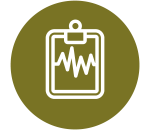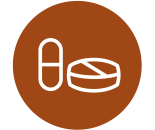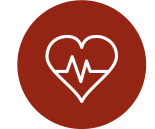

At the end of 2018, about 1.2 million people in the United States were living with HIV. Some groups of people in the United States are more likely to get HIV than others because of many factors, including the status of their sex partners, their risk behaviors, and where they live.
When people get HIV and don't take HIV medicine, they will typically progress through three stages of disease, one after the other: 1) acute HIV infection; 2) clinical latency, and 3) acquired immunodeficiency syndrome (AIDS).
There are also different types of HIV. It is possible, though rare, for people who have one type of HIV to get another type of HIV also; this is called superinfection.
Get More Answers What is HIV?
What is HIV? How do I know if I have HIV?
How do I know if I have HIV? Can I get or transmit HIV from.
Can I get or transmit HIV from. What can increase HIV risk?
What can increase HIV risk? What can decrease HIV risk?
What can decrease HIV risk? How can I prevent getting or
How can I prevent getting or
HIV stands for human immunodeficiency virus. The virus can lead to acquired immunodeficiency syndrome, or AIDS, if not treated. Unlike some other viruses, the human body can’t get rid of HIV completely, even after treatment.
Right now, there is no cure for HIV. But with proper medical care, HIV can be effectively controlled. Treatment for HIV is called antiretroviral therapy or ART. If taken as prescribed, ART can dramatically prolong the lives of many people who have HIV and keep them healthy. Also, people with HIV who take HIV medicine as prescribed and keep an undetectable viral load will not transmit HIV through sex. Before the introduction of ART in the mid-1990s, people with HIV could progress to AIDS (the last stage of HIV infection) in a few years. Today, someone who gets an HIV diagnosis and starts treatment in the early stages of the disease can live nearly as long as someone who does not have HIV.
HIV attacks the body’s immune system , specifically the CD4 cells . These special cells help the immune system fight off infections. If HIV isn’t treated, it reduces the number of CD4 cells in the body. This damage to the immune system makes it harder and harder for the body to fight off infections and some other diseases.
If HIV infection isn’t treated, a person is more likely to get other infections or infection-related cancers. These opportunistic infections or cancers take advantage of a very weak immune system and make the person even sicker.
![]()
More information:
Opportunistic illnesses are infections and infection-related cancers that are more common or more severe in people with HIV because their immune systems are damaged. Examples include Kaposi's sarcoma, lymphoma, tuberculosis, and pneumonia.
Only certain body fluids —from a person with HIV can transmit HIV. The body fluids that can transmit HIV are blood, semen (cum), pre-seminal fluid (pre-cum), rectal fluids, vaginal fluids, and breast milk. For transmission to occur, these fluids must come in contact with a mucous membrane or damaged tissue or be directly injected into the bloodstream (from a needle or syringe) of a person without HIV. Mucous membranes are found inside the rectum , vagina, penis, and mouth.
You can get or transmit HIV only through specific activities. Most commonly, people get or transmit HIV through sexual behaviors and needle or syringe use. However, there are ways to greatly reduce your risk of getting or transmitting HIV from these activities, such as
Learn more about how HIV is and isn’t transmitted in the United States.
![]()
More Information
HIV is most often transmitted by
Less commonly, HIV may be transmitted by
In extremely rare cases, HIV may be spread by
HIV isn’t transmitted by

![]()
About 1.2 million people in the United States have HIV. In 2018, nearly 38,000 people received an HIV diagnosis in the United States and dependent areas. Though the number of new HIV diagnoses has declined over the last few years, the number of people who have HIV has been increasing because people with HIV are now living longer.
In 2018, 81% of new diagnoses in the United States and dependent areas were among adult and adolescent men and 19% were among adult and adolescent women. Most new HIV diagnoses among women were from heterosexual contact (85%), and another 15% were from injection drug use. By age, 21% of new HIV diagnoses in 2018 were among young people aged 13 to 24, 36% were among people aged 25 to 34, 19% were among people aged 35 to 44, 14% were among people aged 45 to 54, and 10% were among people aged 55 and older.
When you live in a community where many people have HIV infection, the chances of having sex with someone who has HIV are higher. This interactive atlas allows you to see the rates of HIV infection (“ prevalence ”) in different US communities. Within any community, the prevalence of HIV can vary among different populations.
HIV is transmitted when engaging in risky behaviors, like (1) having anal or vaginal sex without a condom or without taking medicine to prevent or treat HIV and (2) sharing needles, syringes or other injection equipment (for example, cookers). Certain cultural and societal factors can also play a part in HIV risk. These factors include poverty, lack of educational opportunities, lack of access to health care, homophobia , stigma, and racial/ethnic or gender discrimination.
Overall, data show
![]()
More information: About 4% of the US male population is gay or bisexual, but gay and bisexual men accounted for 86% of all new HIV diagnoses among men and 69% of all diagnoses in 2018. The number of new HIV diagnoses among gay and bisexual men was highest in men aged 25 to 34. Young black/African American gay and bisexual men (aged 13 to 24) accounted for 51% of new diagnoses among all young gay and bisexual men and 34% of new diagnoses among all black/African American gay and bisexual men.
![]()
More information:Many factors may increase HIV risk for some gay, bisexual, or other men who have sex with men (MSM). For example,
![]()
More information: About 13% of the US population is black/African American, but they accounted for 42% of new HIV diagnoses in 2018. Similarly, although about 18% of the total US population is Hispanic/Latino, they accounted for 27% of new HIV diagnoses in 2018.
![]()
More information: Many cultural, socioeconomic, and health-related factors may increase HIV risk for some African Americans and Hispanics/Latinos. For example,
![]()
More information: Because we don’t have complete data for this population, we don’t know how many transgender women in the United States have HIV. However, data collected by local health departments and scientists studying these communities show high levels of HIV infection, with a recent study reporting that an estimated 14% of transgender women have HIV.
![]()
More information: Many cultural, socioeconomic, and health-related factors may increase HIV risk for some transgender people. For example,
![]()
More information: In 2018, 7% of new HIV diagnoses in the United States and dependent areas were attributed to injection drug use and another 3% to male-to-male sexual contact and injection drug use (men who reported both risk factors). Of the HIV diagnoses attributed to injection drug use, 58% were among men and 42% were among women.
![]()
More information: Many factors may increase HIV risk for some people who inject drugs (PWID). For example,